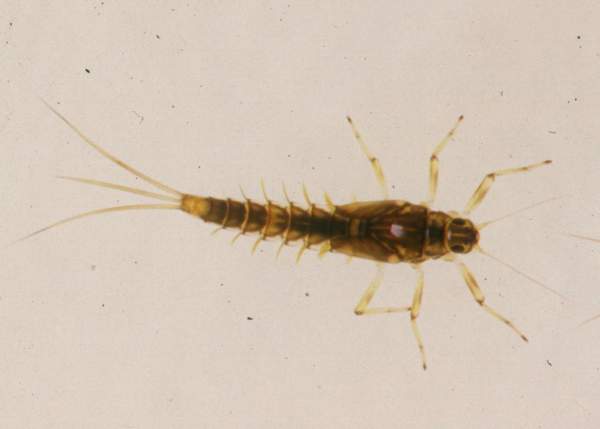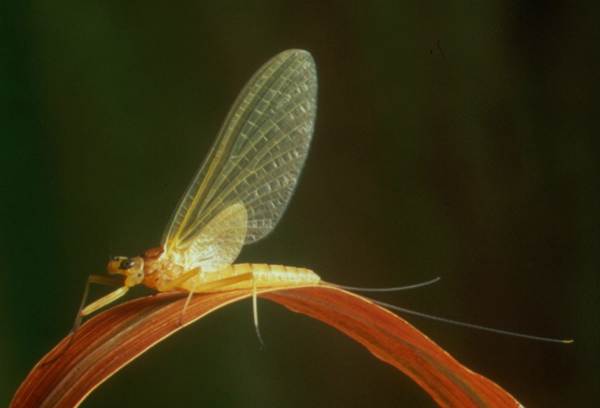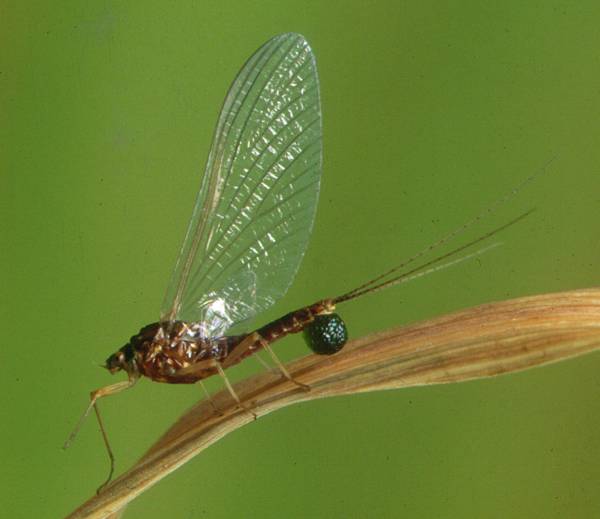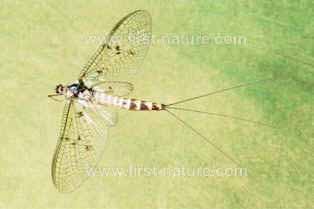Trees Birds Mammals Fish Amphibians Reptiles
Wild Algarve
Bookshop
Ephemeroptera - the Up-winged Flies
There are at least forty-five species of up-winged flies in the British Isles.
They get their common name from the habit of holding their wings upright
above the body when at rest, rather as a butterfly does. Here are some up-winged flies of Britain and Ireland that are of greatest importance to trout and grayling - and therefore also to flyfishers:
This GALLERY PAGE has links to larger pictures and information about each species. A Sortable Table version of this page is also available...
Caenis species

Iron Blue

Lake Olive

Mayfly

Medium olive

Olive Upright

B-W Olive

Yellow May

Dusky Yellowstreak

Autumn Dun

Large Dark Olive

Pale Watery

Pond Olive

Sm Dark Olive

Pale Evening

Small Spurwing

Turkey Brown

Matching the Hatch
Of all the groups of aquatic insects, it is the up-winged flies that have most intrigued and captivated the interest of flyfishers down the ages. The reason is more to do with practicality than with the undeniable beauty of these ephemeral winged insects. Trout and grayling rise avidly to upwinged flies, and at times they feed on one species, sometimes even selecting just one particular lifecycle stage, to the exclusion of all else. If you cannot match the hatch with a reasonably good artificial fly, your fishing is much less productive and a lot less fun.
That's why I wrote Matching the Hatch, and so far many tens of thousands of flyfishers have found it useful.
In any case, in the individual species pages on this section of the First Nature website I have included at least some basic information to get you started in choosing artificial flies of the right size and pattern to match the natural insects fairly well, and you can always go into the subject in more detail later.
Flyfishing tips and tactics
Using the right kind of artificial fly is only the first step in matching the hatch. A crucially important topic (and one that is covered extensively in Matching the Hatch) is that of making your fly behave like the insect it is meant to represent. Inappropriate behaviour will give the game away even more quickly than using a fly of the wrong size, design of colour (and I should add that colour is often the least important of these key factors). Again in each species page on this section of the First Nature website you will find some basic information on this fascinating and very rewarding topic.
Life Cycle of the Ephemeroptera
All upwinged flies go through four distinct phases: egg, nymph, dun and
spinner. The first two phases are spent under water, while duns and spinners
are the winged stages in the life cycle.
Nymphs

Nymph of the Iron Blue, Alainites muticus
The nymphs, which have three tails, feed mainly on algae and rotting
vegetation. They are categorised according to how they have adapted to suit
different habitats.
- Burrowers: nymphs that live in tunnels beneath the mud, sand and
gravel, venturing above the bed of the river or the lake only when ready
to hatch. In the British Isles, the Mayfly alone falls into this category.
- Silt crawlers: a group of tiny nymphs which crawl upon the silty beds
of rivers and lakes, feeding among the detritus. The Caenis nymphs are included in this group.
- Stone clingers: a third group of relatively inactive nymphs which
spend most of their time clinging to the undersides of stones, where
they feed by grazing on algae. The nymphs of the March
Brown and the Yellow
May dun are stone clingers.
- Moss creepers: a very feeble-swimming group of nymphs, which feed
among mosses on the river bed. The blue-winged olive belongs to this
group.
- Laboured swimmers: slightly flattened nymphs which spend most of their
time in the margins and can swim from place to place, but only slowly.
The claret nymph is one of the laboured swimmers.
- Agile darters: torpedo-shaped creatures of special interest to anglers
because they swim rapidly from place to place in search of new feeding
spots and are therefore available to trout even when there is no hatch
of flies. The nymph of the Iron
Blue is an agile darter.
After typically one year, the nymphs are ready to emerge as winged
insects. (Some of the up-winged flies of springtime produce a second generation later in the year - the Large Dark Olive, Baetis rhodani, for example.)
Dun

A female dun of the Yellow May
From the nymphal case a fly called a dun emerges. The scientific name for this stage in the lifecycle of an up-winged fly is 'subimago', but anglers use the term dun because many of the olive flies have dun-coloured (olive-brown) bodies at this stage in their development. the Yellow May, shown here, is an example of a fly where the term dun is far from accurately descriptive!
The dun's wings are
dull and fringed with tiny hairs, and its tails are much longer than those
of the nymph from which it 'hatched' (an imprecise angling term, since
strictly the nymph hatches from the egg and later transposes into dun and
then spinner forms). (In the next stage the tails will grow even longer.)
Once its wings have opened up fully, which can take several seconds, the dun flies to a nearby tree;
there it rests until ready to shed one more skin in preparation for its
final act of mating.
Egg-laying Spinner

A Blue-winged Olive with her ball of eggs
After anything from a few seconds to a few days, the dun splits its
skin and out crawls the adult spinner. Gone are the hairy fringes and most
of the colour from the wings, and the tails are noticeably longer than those
of the dun. At last the insect is ably to fly off in search of a mate.
After mating, the female heads off back to the water to lay her eggs,
either on the surface or, in the case of the Baetis flies, more often by
crawling down plant stems of semi-submerged boulders and attaching them to rocks, plants or logs beneath the water.
Spent Spinner

Once the female spinner has released her eggs, she falls exhausted onto the
water, flutters awhile and then drifts inert with her wings outstretched.
Trout can sip them leisurely from the surface.
Baetis spinners that have crawled down below the surface to lay their
eggs approach the surface from the other direction and can become trapped
just below the surface.
Etymological note: We use the terms flyfishing and flyfisher throughout our pages, but some people still write fly fishing, fly fisher and fly-fishing techniques.
Entomological note: The diversity and particularly the abundance of flylife (or if you prefer fly life) on rivers and streams in Britain and Ireland has declined dramatically over the past forty years. We support the Riverfly Partnership's campaign to raise awareness of this issue, to involve anglers and others in scientific monitoring of water quality via aquatic invertebrate diversity, and to promote actions to halt and reverse this decline.
References
In identifying up-winged flies to species level we make extensive use of two Freshwater Biological Association publications:
A key to the Adults of the British Ephemeroptera with notes on their ecology; J M Elliott and U M Humpesch (1983). FBA Scientific Publication No. 47.
Larvae of British Ephemeroptera: a key with ecological notes; J M Elliott, U H Humpesch and T T Macan (1988). FBA Scientific Publication No. 49.
For flyfishers on stillwater, river and stream there is an illustrated guidebook with advice on corresponding artificial flies plus fishing tips:
Matching the Hatch, Pat O'Reilly; Quiller Publications (1997, latest reprint 2010) ISBN 978 1 85310 822 8
Excited by rivers and streams? So are we, and we're pretty sure you would find the Winding River Mystery trilogy of action-packed thrillers gripping reading too. Dead Drift, Dead Cert, and Dead End are Pat O'Reilly's latest river-based novels, and now they are available in ebook format. Full details on our website here...
Buy each volume in ebook format for only £2.47 on Amazon... Paperbacks also available on Amazon at £6.95 each. All proceeds go towards keeping the First Nature website online.
Please Help Us: If you have found this information interesting and useful, please consider helping to keep First Nature online by making a small donation towards the web hosting and internet costs.
Any donations over and above the essential running costs will help support the conservation work of Plantlife, the Rivers Trust and charitable botanic gardens - as do author royalties and publisher proceeds from books by Pat and Sue.